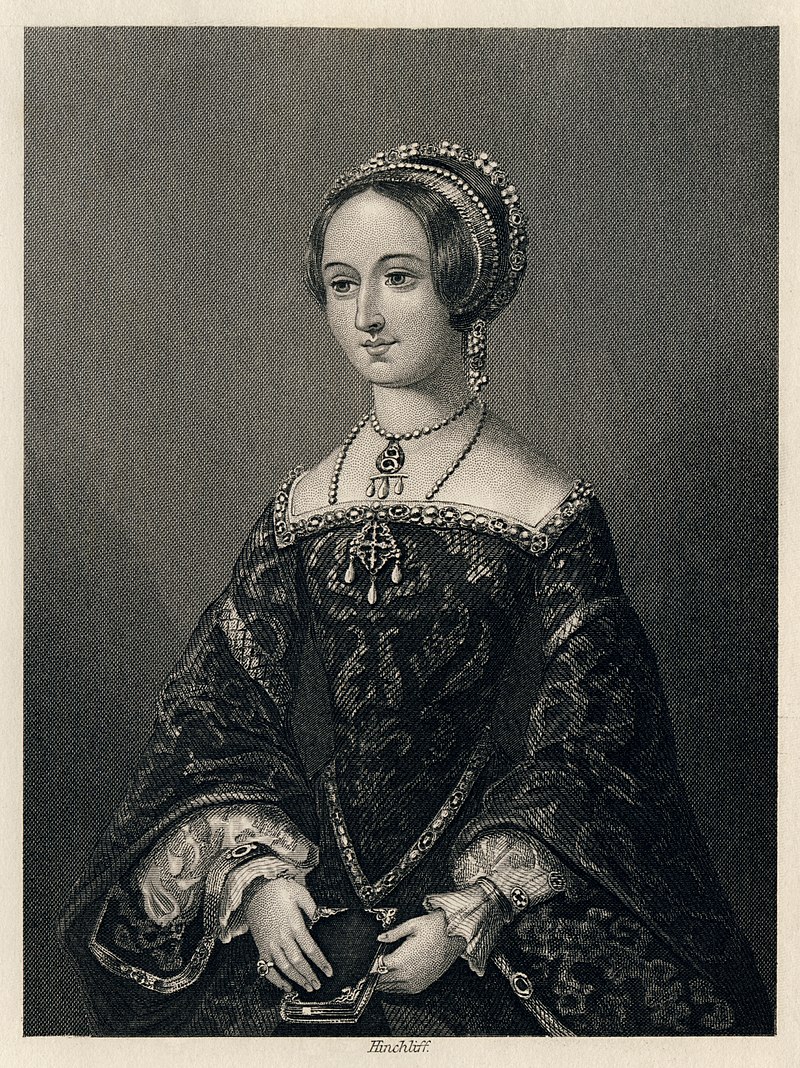John James Hinchcliff, Marguerite Queen of Navarre,
engraving from an English translation of The Heptameron published in 1864.
Image courtesy of Wikimedia Commons.
In his translations, George Saintsbury provides a brief biography of Margaret which is well worth a thorough perusal. The portrait Saintsbury paints of Margaret is an impressive one; he describes her as a highly cerebral, politically astute woman who was sensitive to sufferers of religious persecution. He recounts the passtimes she enjoyed, as described by her biographer Brontome, who elucidated that when "she was alone in her room she more often held a book in her hand than a distaff, a pen than a spindle, and the ivory of her tablets than a needle... 'And if she applied herself to tapestry or other needlework, such as was to her a pleasant occupation, she had beside her some one who read to her, either from a historian or a poet, or some other notable and useful author; or else she dictated some meditation which was written down'" (Saintsbury 1894).
From this account of Margaret's life, I stumbled upon yet another important clue: her visual composition of emblems and devices. Saintsbury describes how "Margaret was not only given to versifying, but was fond of' framing devices, which she inscribed upon her books and furniture. At one time she adopted as her device a marigold turning towards the sun's rays, with the motto, 'Non inferiora secutus,' implying that she turned 'all her acts, thoughts, will, and affections towards the great Sun of Justice, God Almighty'" (Saintsbury 1894). According to Margaret Swain, who interprets the motto to mean "Following no mean things", this imagery also appearsin Paradin's book of emblems Les Devices Heriques, first published in Lyons in 1557 (1970:20).
Pictured left: The impresa of Margaret of Navarre worked as an octagonal applique panel by Mary Queen of Scots (note the motto anagram in the righthand corner) on the Oxburgh hangings.
Tent and cross stitch in coloured silk on canvas, 43 cm wide.
Pictured right: An emblem from Paradin's Devises Heroiques, Lyons (1557), 11.5 x 7 cm.
Images courtesy of Swain, 1970:25.
Not only does this emblem appear in Mary Stuart's work on the Oxburgh Hangings (Swain 1970), it also appears on the curious Shepherd's Buss -- more to come on that later -- described by Digby (1963). Swain attributes this reference to Mary's familial relation to Margaret, who was her sister-in-law (1970), and undoubtedly played a role in Mary's intellectual development. Thus do our noble needlewomen -- Mary, Bess, and Elizabeth -- pay intellectual homage to a keenly intelligent and an indubitably inspirational woman; Mary and Bess through their collaboratively executed hangings which feature a replication of Margaret's impresa, and Elizabeth through her reproduction of Margaret's penmanship, replete with embroidered cover.
So I have decided to take a page out of Margaret's book (no pun intended), and listen to her words while I engage in needlework. Sometimes, active hands can be conducive towards meditation, and having a pleasant voice read to you is a good way to still a wandering mind. To be distracted in needlework is a perilous blunder -- leading to inadvertant pricks and erroneous stabs, and perhaps more vexing still: knots. This was something that I had come to realize years ago while learning how to bead moccosins and sew button blankets under the tutelage of Peter Morin. I remember, very vividly, when he told his students that frequent snares, tangles, and knots are an indication that your mind has wandered. It prevails upon the stitcher to refocus his or her attention. It's almost as if tensions of the mind are unknowingly expressed as tensions in the body, which confounds your stitching and tests your patience.
The Tales of the Heptameron of Margaret, Queen of Navarre, translated by George Saintsbury.
Image courtesy of The Project Gutenburg.
The other thing that I've noticed is that listening a gentle voice reading alound is conducive for achieving what is referred to in popular psychology as flow. Perhaps it is a human universal, familiar to everyone: that sensation of complete immersion, effortless concentration, maximum enjoyment and easy execution of a task -- peak performance. It's almost as though the cadence of the voice flows through the pentameter of the written word and establishes a rhythm by which the sewer moves. The passage of time elapses unnoticed as the words and the stitches fly by. I find it a highly stimulating and simultaneously comforting way in which to work. Margaret's words, which have an eloquence and grace to today's ears, and her apparent verbosity as well as her talent as a storyteller seem to cultivate an air of elevation; by my sheer exposure to it, I feel morally and intellectually improved, ennobled somehow. It certainly cultivates a particular working disposition; one in which mind and body worth together, but seperately; our hands work, but our minds wander -- not too far, lest we go astray.
Sources Cited
Digby, George Wingfield
1963 Elizabethan Embroidery. London, England: Faber and Faber.
Saintsbury, George, trans.
1894 The Tales of the Heptmeron Vol I (of V) by Marguerite, Queen of Navarre. London, England: The London Bibliophilist's Society.
Swain, Margaret
1970 Historical Needlework: A Study of Influences in Scotland and Nothern England. London, England: Barrie and Jenkins.




No comments:
Post a Comment